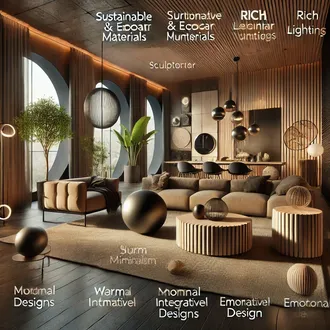Transcription Principles of decoration (2)
All the elements that make up the interior rooms (space, furniture, lighting and accessories) should be organized in the following logical order:
- The functional needs.
- The desires of the clients.
- The aesthetic criteria of the decorator.
In order for the decoration to transmit aesthetic values, all the parts or elements must be integrated into a whole following guidelines of proportion, scale, balance, harmony, unity, rhythm and emphasis. Although these principles must be taken into account to maintain a sense of order in the visual space, they cannot be adopted as immovable rules of obligatory compliance.
Proportion
Proportion. Proportion is the relationship of correspondence that is established between each of the parts of a whole with the whole, or between the different parts with each other. This principle helps us to consider the relative size of objects. The correspondence can be of magnitude, quantity or degree.
MAGNITUDE QUANTITY DEGREE: It should be noted that the apparent size of an element depends on the relative sizes of the surrounding objects. Generally speaking, a decoration is considered proportionally correct when no element or attribute used is too small or too large.
Scale
This principle is closely related to that of proportion since it also allows us to consider the relative size of objects, but it makes it possible in a different way. Scale refers to the relation of the size of objects to certain parameters. Three types of scales can be distinguished:
- The mechanical scale: it refers to the estimate we make of a physical size, taking into account standardized parameters. For example: a table lamp can measure up to 75 centimeters in height, while a floor lamp can exceed 150 centimeters. Therefore, if we are familiar with these parameters, we would not make the mistake of placing one lamp in place of the other.
- The visual scale: It refers to the estimate of the size that something appears to have when we compare it with the elements that surround it. For example: if we want to place a single painting on a wall, its dimensions must be in correspondence with the dimensions of the wall: a large wall requires a large painting.
- Human scale: This refers to the estimation of the dimensions of the interior space and the objects it contains, taking human dimensions as a reference. For example: the ideal height to place a painting should be 170 centimeters, a height that is slightly above the eye level of people of medium height.
The decorator must know how to manage an appropriate scale ratio to achieve balance between all the elements that make up a room, but should not rule out the possibility of altering the normal scale ratios, to draw attention to certain points or objects of interest.
Balance
The visual balance of the set of objects that make up an interior space with its different shapes, sizes, colors, textures, positions and orientation, must be conceived taking into account the three dimensions of space: height, width and depth.
There are three types of visual balance: symmetrical, radial and asymmetrical. Symmetrical balance (known as axial or bilateral symmetry), consists of arranging a group of objects of identical shapes and sizes around a central imaginary axis.
Generally, symmetrical balance conveys stability, tranquility and calm, especially when it is oriented in the vertical plane, constituting a simple mechanism to organize one or more parts of a space.
Radial balance consists in the organization of objects around a central element. This distribution can be oriented towards the center or towards the outside, allowing us to highlight the point where we want to focus more attention.
The asymmetrical balance consists of the incorporation of different objects in terms of size, shape, color or relative position within the composition. To achieve asymmetrical balance the decorator must combine objects that attract attention (bright colors, bold shapes, textures, etc.) with larger, less conspicuous objects relatively far from the center.
Asymmetrical balance is less obvious than symmetrical and radial balance, but it is more flexible, so it can be more easily adapted to the various requirements of the space and decorative functions. It has the ability to convey movement, change and dynamism.
principles 2




